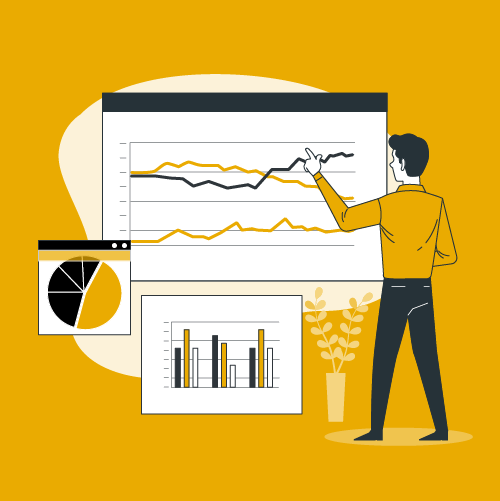- What is Data Mining in Business?
- How is Data Mining Used in Business Intelligence?
- Business Understanding
- Data Understanding
- Data Preparation
- Data Modeling
- Data Evaluation
- Implementation
- An Overview of Data Mining Techniques
- Classification
- Clustering
- Association Rules
- Regression Analysis
- Anomaly Detection
- Explore Enterprise BI like Never Before
Data is the life-powering proverbial blood that empowers the corporate economy of the 21st century. And although it may incite fanciful scenarios to mind with a mere mention, the truth is data is key to unlocking human productivity in every sphere of life. Climate change, business failures, epidemics, and crop production, all can be understood with the right set of data insights. Data availability cuts short the learning tangent for us in problem-solving.
Just as finding the right product-market-fit is important for enterprises, so is data mining for business intelligence for a future-ready, self-sustaining venture. It helps in future road mapping, product development, and umpteen business processes that keep the profit-wheel rolling. Therefore, in this article, we’ll be articulating topics that relate to data mining and business intelligence, the importance of data mining, and how it is carried out to ensure seamless revenue flows.
What is Data Mining in Business?
The importance of data mining in business is that it is used to turn raw data into meaningful, consumable, actionable insights. Data engineers employ software to look up patterns that aid in analyzing consumers. Data sets are compared to unearth relevant metrics having an impact on revenue lines to follow up with strategies, sales improvement measures, and optimizing marketing campaigns.
Due to the overlapping nature of the subject between data operations, data mining is often confused and used interchangeably with data analysis and business intelligence. But each term is different from one another.
Data mining refers to the process of extracting information from large data sets whereas data analysis is the process used to find patterns from the extracted information. Data analysis involves stages such as inspecting, cleaning, transforming, and modeling data. The objective is to find information, draw inferences, and act on them. Moving on, let us look at the differences between data mining and business intelligence.
| Feature | Data Mining | BI |
|---|---|---|
| Purpose | Extract data to solve business problems | Visualizing & presenting data to stakeholders |
| Volume | Work on smaller data sets for focused insights | Work on relational databases for organizational-level insights |
| Results | Unique data sets in a usable format | Dashboards, pie charts, graphs, histograms, etc. |
| Focus | Highlight key performance indicators | Indicate progress on KPIs |
| Tools | Data mining techniques use tools like DataMelt, Orange Data Mining, R, Python, and Rattle GUI | Business Intelligence techniques use tools like Sisense, SAP for BI, Dundas BI, and Tableau |
Processes like data mining and data analysis converge into business intelligence helping organizations generate usable and demonstrable information on products and services.
How is Data Mining Used in Business Intelligence?
The way we use data mining for business analytics and intelligence varies from one business to another. But there is a structure to this business process management that remains pretty much iron clad. Here’s a look at it.

Business Understanding
If you are undertaking data mining for business analytics and want it to be successful then begin by identifying the purpose of data mining. Subsequent steps in the plan could tackle how to use the newfound data bits. Ideating your data mining algorithm would be a far-fetched task lest you underline the purpose of data mining concisely.
Data Understanding
After getting to know the purpose of data mining it is time to get a touch and feel for your data. There could be just as many ways to store and monetize data as there are businesses. How you create, curate, categorize, and commercialize your data is upto your enterprise IT strategy and practices.
Data Preparation
Considered one of the most important stages in the course of nurturing data mining for business intelligence, company data needs expert handling. Data engineers convert data into a readable format that non-IT professionals can interpret in addition to cleansing and modeling it as per specific attributes.
Data Modeling
Statistical algorithms are deployed to decipher hidden patterns in data. A lot of trial and error goes into finding relevant trends that can enhance revenue metrics.
Data Evaluation
The steps involved in data modeling should be evaluated microscopically for inconsistencies. Remember, all roads (must) lead to streamlining operations and augmenting profits.
Implementation
The final step is to act on the findings in an observable way. Field trials of the recommendations should be piloted at a smaller scale and then expanded onto branch outlets upon validation.
Now you know how the build-up of milestones distills into ground reality. Let us explore some of the technicalities of data mining for business intelligence.
An Overview of Data Mining Techniques
In this section, we will look over each rung of the data mining ladder and how they act as stepping stones for future growth.

Classification
This is a complex procedure that uses data attributes to compartmentalize information to draw understandable collusions. As a reference to this, an example of data mining in business could be using supermarket data to group information into categories such as groceries, dairy products, etc. Tagging and studying this data can help users understand customer preferences for each line item.
Clustering
Although it may sound similar to the previous step yet there are differences. Cluster groups are not as defined in structure as Classification groups. An example could be edible items, non-edible items, perishable products, etc. instead of specific groceries, dairy products in the earlier case.
Association Rules
Here, we use link variables to track patterns. Continuing on our supermarket example, this could mean customers who purchase a grocery item (edible), are more likely to purchase fruits (perishable) as well. Upon validating this fact, store owners can itemize the shelves in accordance with customer choices.
Regression Analysis
Regression helps miners determine the relationship between different variables in a set. It is used to foresee the probability of a future event. In the case of a supermarket store, business owners can set price points based on seasonal demand, competition, and supply chain issues.
Anomaly Detection
The last of the data mining techniques includes identifying outliers. There will always be anomalies in the data which have to be accounted for. For instance, the majority of buyers in the supermarket happen to be females but for a week in (say) January they are displaced by men. Why? Such outliers have to be studied for a balanced approach.
The aforementioned techniques make clear how data mining is used in business operations. Drawing this piece to an end, we can conclude that data mining and business intelligence go hand in hand and that one compliments another.
Explore Enterprise BI like Never Before
Appinventiv is a leading business intelligence consulting services organization that offers end-to-end BI services that are second to none. With almost a decade of industry expertise, we’ve successfully launched many projects implementing business intelligence techniques with a client satisfaction rating of over 70%. Some of the services that we offer in this field include:
- BI consulting
- Enterprise BI solutions
- BI implementation
- BI support & maintenance
Our portfolio of work includes successful partnerships with several global brands.
For one of the leading telecom companies in the US, we deployed an effective data mining and BI solution that led to achieving results such as 100% processing of customer data and 85% increase in data quality and accessibility. Don’t worry, we don’t bite if you call and enquire about how we can help you up your game 😉 We’ll be waiting to hear from you (if you find our pitch interesting)!



How Business Intelligence is Driving Data-Driven Decisions in Manufacturing
As the manufacturing sector becomes increasingly intricate, leveraging data effectively has never been more critical. Manufacturers today navigate a labyrinth of processes, technologies, and human capital, all while striving for greater efficiency and innovation. This is where business intelligence for manufacturing emerges as a game-changer. By transforming complex datasets into actionable insights, BI enables organizations…

BI for financial services - How to build a successful BI strategy for your FinTech business?
Considering the volume of data financial service sectors disperse across applications, achieving a 360-degree view of customers and business as a whole can be challenging. This is where business intelligence for financial services comes into play. A robust BI solution for a financial services business helps convert a large amount of data into actionable insights.…

How Business Intelligence Benefits the Retail Industry
Retail is one of the most data-driven industries globally, so using business intelligence tools to understand customer behavior, estimate inventory needs, and build forecasts is the life’s blood of any retailer. BI helps retailers organize, analyze, and contextualize business data from around the company. It also provides reports, performance measures, and company trends that help…










